Unit 4 Where’s my backpack period 2
- 格式:ppt
- 大小:2.26 MB
- 文档页数:30
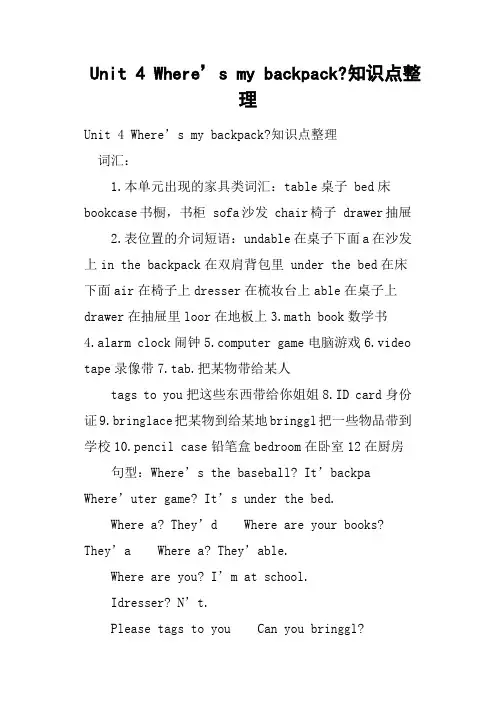
Unit 4 Where’s my backpack?知识点整理Unit 4 Where’s my backpack?知识点整理词汇:1.本单元出现的家具类词汇:table桌子 bed床bookcase书橱,书柜 sofa沙发 chair椅子 drawer抽屉2.表位置的介词短语:undable在桌子下面a在沙发上in the backpack在双肩背包里 under the bed在床下面air在椅子上dresser在梳妆台上able在桌子上drawer在抽屉里loor在地板上3.math book数学书4.alarm clock闹钟puter game电脑游戏6.video tape录像带7.tab.把某物带给某人tags to you把这些东西带给你姐姐8.ID card身份证9.bringlace把某物到给某地bringgl把一些物品带到学校10.pencil case铅笔盒bedroom在卧室12在厨房句型:Where’s the baseball? It’backpa Where’uter game? It’s under the bed.Where a? They’d Where are your books? They’a Where a? They’able.Where are you? I’m at school.Idresser? N’t.Please tags to you Can you bringgl?The bl 语法: 1,询问人或物品在哪里,我们用Where, 结构为 where+is/are+人/物品名称? “……在哪里” 回答用主语+is/are +in/at/under/on/near +地点注意:表示“在……地方”地点前要用定冠词the 或者形容词性物主代词my/your/his/their修饰,但是两者不能同时出现,我们可以说但是绝对不可以词语用法:1, take v.带走,把人或物品带到别的地方去,take …to… 把……带到……去bring v.带来,把人或物品从别的地方带到说话的地方来bring…to… 把……带到……来2,please 后接动词用原形。
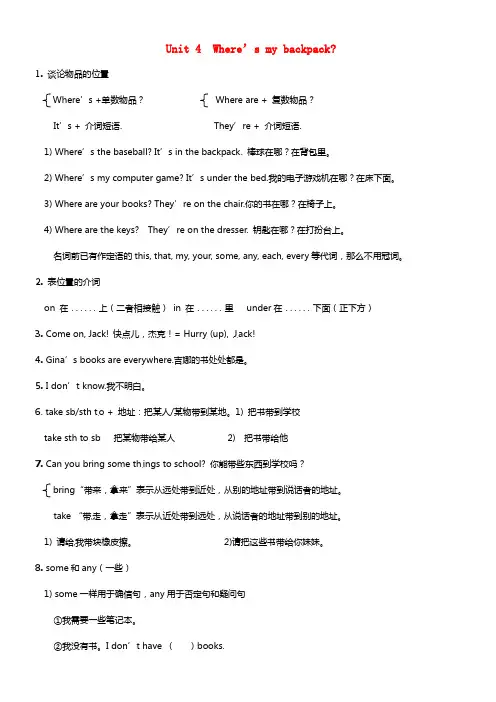
Unit 4 Where’s my backpack?1.谈论物品的位置Where’s +单数物品?Where are + 复数物品?It’s + 介词短语. They’re + 介词短语.1) Where’s the baseball? It’s in the backpack. 棒球在哪?在背包里。
2) Where’s my computer game? It’s under the bed.我的电子游戏机在哪?在床下面。
3) Where are your books? They’re on the chair.你的书在哪?在椅子上。
4) Where are the keys? They’re on the dresser.钥匙在哪?在打扮台上。
名词前已有作定语的this, that, my, your, some, any, each, every等代词,那么不用冠词。
2.表位置的介词on 在......上(二者相接触)in 在......里under在......下面(正下方)3. Come on, Jack! 快点儿,杰克!= Hurry (up), J ack!4. Gina’s books are everywhere.吉娜的书处处都是。
5.I don’t know.我不明白。
6. take sb/sth t o + 地址:把某人/某物带到某地。
1) 把书带到学校take sth to sb 把某物带给某人2) 把书带给他7. Can you bring some th ings to school? 你能带些东西到学校吗?bring“带来,拿来”表示从远处带到近处,从别的地址带到说话者的地址。
take “带走,拿走”表示从近处带到远处,从说话者的地址带到别的地址。
1) 请给我带块橡皮擦。
2)请把这些书带给你妹妹。
8. some和any(一些)1) some一样用于确信句,any用于否定句和疑问句①我需要一些笔记本。
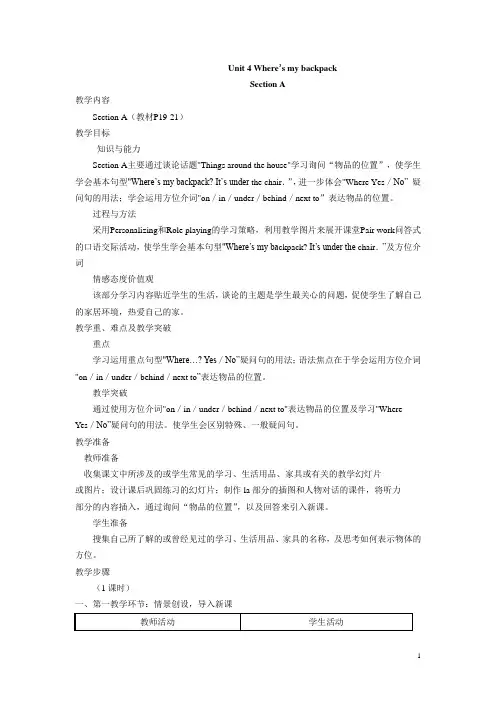
Unit 4 Where’s my backpackSection A教学内容Section A(教材P19-21)教学目标知识与能力Section A主要通过谈论话题"Things around the house"学习询问“物品的位置”,使学生学会基本句型"Where’s my backpack?It’s under the chair.”,进一步体会"Where Yes/No”疑问旬的用法;学会运用方位介词"on/in/under/behind/next to”表达物品的位置。
过程与方法采用Personalizing和Role playing的学习策略,利用教学图片来展开课堂Pair work问答式的口语交际活动,使学生学会基本句型"Where’s my ba ckpack? It’s under the chair.”及方位介词情感态度价值观该部分学习内容贴近学生的生活,谈论的主题是学生最关心的问题,促使学生了解自己的家居环境,热爱自己的家。
教学重、难点及教学突破重点学习运用重点句型"Where…? Yes/No”疑问句的用法;语法焦点在于学会运用方位介词"on/in/under/behind/next to”表达物品的位置。
教学突破通过使用方位介词"on/in/under/behind/next to"表达物品的位置及学习"Where Yes/No”疑问句的用法。
使学生会区别特殊、一般疑问句。
教学准备教师准备收集课文中所涉及的或学生常见的学习、生活用品、家具或有关的教学幻灯片或图片;设计课后巩固练习的幻灯片;制作la部分的插图和人物对话的课件,将听力部分的内容插入,通过询问“物品的位置”,以及回答来引入新课。
学生准备搜集自己所了解的或曾经见过的学习、生活用品、家具的名称,及思考如何表示物体的方位。
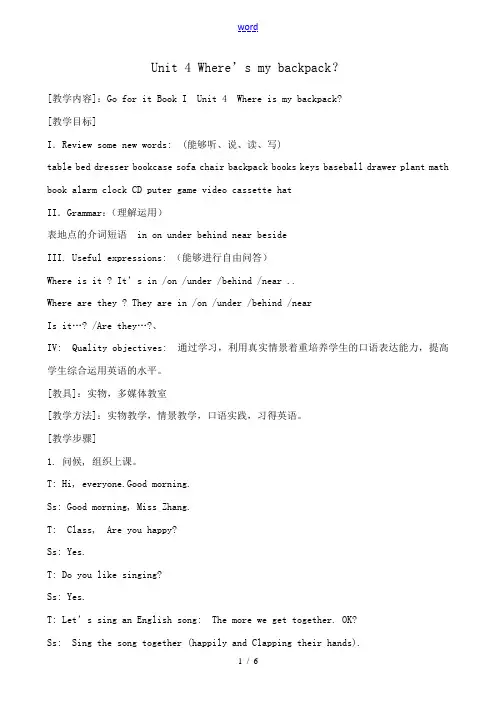
Unit 4 Where’s my backpack?[教学内容]:Go for it Book I Unit 4 Where is my backpack?[教学目标]I.Review some new words: (能够听、说、读、写)table bed dresser bookcase sofa chair backpack books keys baseball drawer plant math book alarm clock CD puter game video cassette hatII.Grammar:(理解运用)表地点的介词短语 in on under behind near besideIII. Useful expressions: (能够进行自由问答)Where is it ? It’s in /on /under /behind /near ..Where are they ? They are in /on /under /behind /nearIs it…? /Are they…?、IV: Quality objectives: 通过学习,利用真实情景着重培养学生的口语表达能力,提高学生综合运用英语的水平。
[教具]:实物,多媒体教室[教学方法]:实物教学,情景教学,口语实践,习得英语。
[教学步骤]1. 问候, 组织上课。
T: Hi, everyone.Good morning.Ss: Good morning, Miss Zhang.T: Class, Are you happy?Ss: Yes.T: Do you like singing?Ss: Yes.T: Let’s sing an English so ng: The more we get together. OK?Ss: Sing the song together (happily and Clapping their hands).2. 通过what’s this?句型及其回答It’s …/They are…复习生词。

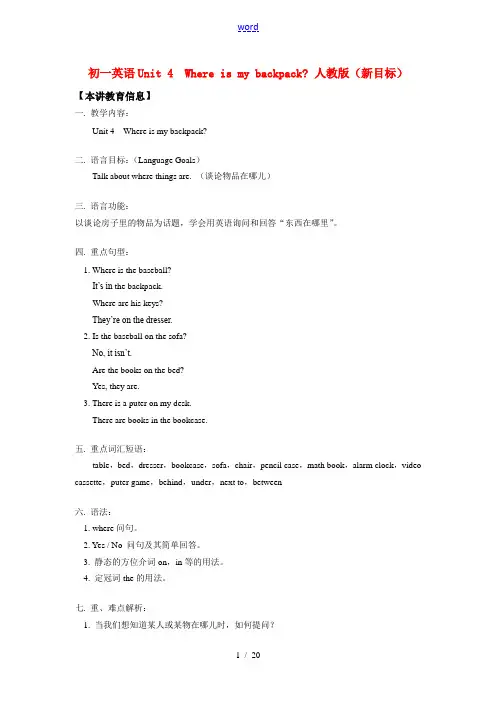
初一英语Unit 4 Where is my backpack? 人教版(新目标)【本讲教育信息】一. 教学内容:Unit 4 Where is my backpack?二. 语言目标:(Language Goals)Talk about where things are. (谈论物品在哪儿)三. 语言功能:以谈论房子里的物品为话题,学会用英语询问和回答“东西在哪里”。
四. 重点句型:1. Where is the baseball?It’s in the backpack.Where are his keys?They’re on the dresser.2. Is the baseball on the sofa?No, it isn’t.Are the books on the bed?Yes, they are.3. There is a puter on my desk.There are books in the bookcase.五. 重点词汇短语:table,bed,dresser,bookcase,sofa,chair,pencil case,math book,alarm clock,video cassette,puter game,behind,under,next to,between六. 语法:1. where问句。
2. Yes / No 问句及其简单回答。
3. 静态的方位介词on,in等的用法。
4. 定冠词the的用法。
七. 重、难点解析:1. 当我们想知道某人或某物在哪儿时,如何提问?Where is / are + … ?当我们想知道某个物品在哪儿时,我们通常用Where is / are … ?句型来提问。
如:Where is my backpack?△where 是疑问副词,意思是在哪里,后面用一般疑问句句型。
△当询问的物品数量为单数时,其前的be 动词应使用is ,因为该物品在问句中提到过,所以回答时用代词it 代替该物品。
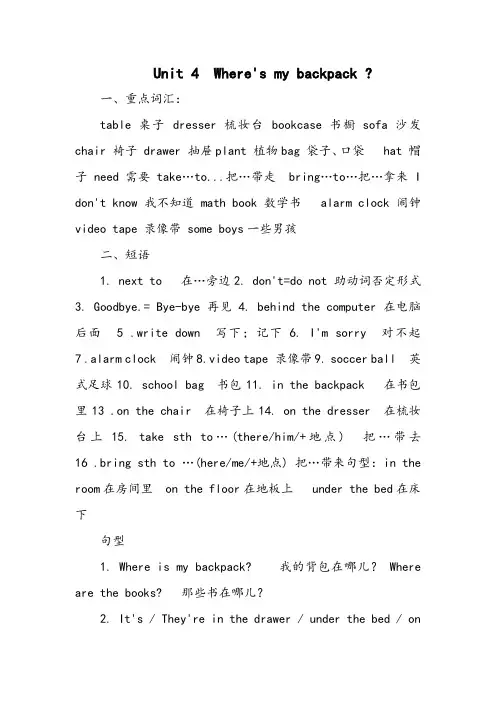
Unit 4 Where's my backpack ?一、重点词汇:table 桌子 dresser梳妆台 bookcase书橱sofa 沙发chair 椅子 drawer 抽屉plant 植物bag 袋子、口袋 hat 帽子 need 需要take…to...把…带走 bring…to…把…拿来 I don't know我不知道 math book数学书 alarm clock闹钟video tape 录像带 some boys一些男孩二、短语1. next to 在…旁边2. don't=do not 助动词否定形式3. Goodbye.= Bye-bye 再见4. behind the computer 在电脑后面 5 .write down 写下;记下 6. I'm sorry 对不起7 .alarm clock 闹钟8.video tape 录像带9. soccer ball 英式足球10. school bag 书包11. in the backpack 在书包里13 .on the chair 在椅子上14. on the dresser 在梳妆台上15. take sth to…(there/him/+地点) 把…带去16 .bring sth to …(here/me/+地点) 把…带来句型:in the room在房间里 on the floor在地板上 under the bed在床下句型1. Where is my backpack? 我的背包在哪儿? Where are the books? 那些书在哪儿?2. It's / They're in the drawer / under the bed / onthe bookcase.它 / 它们在抽屉里 / 床底下 / 书柜上。
(注意主语和be 动词照应)3. Is it / Is the book / on the bed / in the backpack / under the desk?Are they on the bed / in the backpack / under the desk?4. Can you bring some things to school? 你能带些东西去学校吗?some一般用在肯定的陈述句中,any用在否定句(“任何”)或疑问句(“某些,一些”)中。
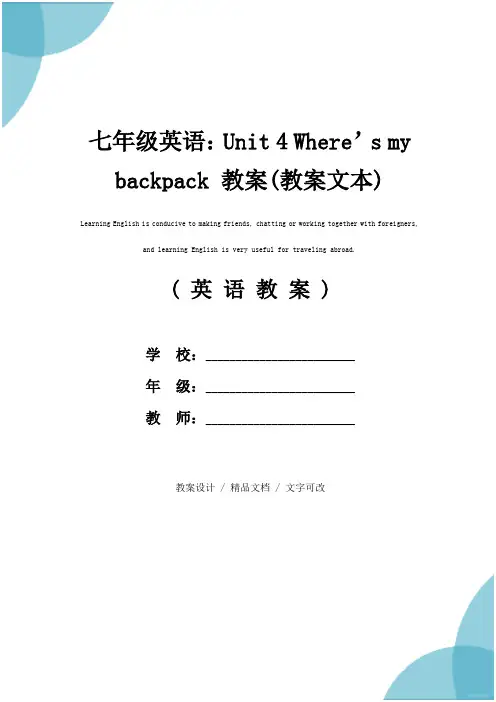
( 英语教案 )学校:_________________________年级:_________________________教师:_________________________教案设计 / 精品文档 / 文字可改七年级英语:Unit 4 Where’s my backpack 教案(教案文本) Learning English is conducive to making friends, chatting or working together with foreigners, and learning English is very useful for traveling abroad.七年级英语:Unit 4 Where’s my backpack教案(教案文本)unit 4 where’s my backpack ?教学内容:本单元主要内容是谈论物品的所在位置,通过这一话题,训练学生的听、说、读、写四项基本技能,让学生通过询问物品的位置,学习一些物品的单词,及方位介词 on , in , under ,behind 等的用法;学习并掌握where句型的运用,使学生养成干净、整洁、合理摆放物品的好习惯。
教学目标:1、知识目标:a、学会一些表示家具的名词以及学习用品的单词;b、方位介词,如:in , on , under , behind的用法;c、学会运用方位介词和where句型表述物品所在的位置。
2、能力目标:a、学会正确描述物品作在的位置;b、学会询问自己或他人物品的具体位置;c、能够合理地描述和设计房间。
3、情感目标:培养学生整齐地摆放自己物品的生活习惯。
教学难点、重点:重点:a、方位介词 in , on , under , behind的用法。
b、where的特殊疑问句和is this a/an . . . ?一般疑问句的肯定和否定回答。
c、学习名词 bed , dresser , bookcase ,backpack . . .难点:a、能够正确运用方位介词描述物品作在的位置;b、能够运用where的问句找到物品位置。
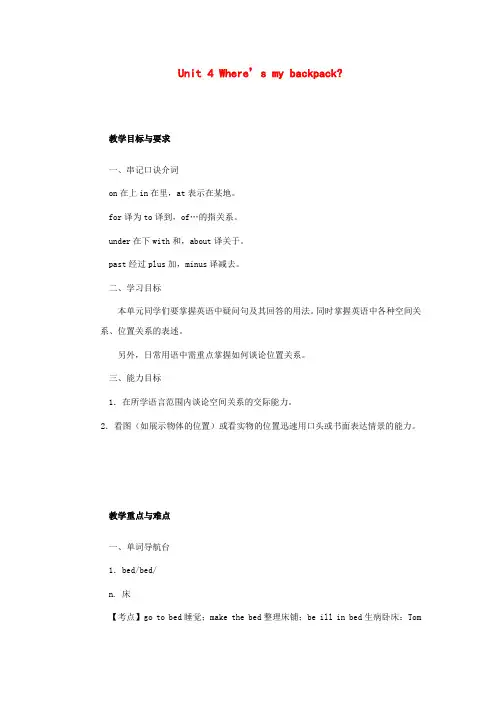
Unit 4 Where’s my backpack?教学目标与要求一、串记口诀介词on在上in在里,at表示在某地。
for译为to译到,of…的指关系。
under在下with和,about译关于。
past经过plus加,minus译减去。
二、学习目标本单元同学们要掌握英语中疑问句及其回答的用法。
同时掌握英语中各种空间关系、位置关系的表述。
另外,日常用语中需重点掌握如何谈论位置关系。
三、能力目标1.在所学语言范围内谈论空间关系的交际能力。
2.看图(如展示物体的位置)或看实物的位置迅速用口头或书面表达情景的能力。
教学重点与难点一、单词导航台1.bed/bed/n. 床【考点】go to bed睡觉;make the bed整理床铺;be ill in bed生病卧床:Tomhas been ill in bed for a month. 汤姆生病卧床一个月了。
in bed的意思是“(在)睡觉,卧床”;bed前无冠词。
get(jump) out of bed下床;put…to bed安顿睡觉。
【引申】bunk bed(小孩用的)上下铺;camp bed行军床;double bed双人床;water bed水床;bedroom卧室。
2.drawern. 抽屉3.next/nekst/adj. (无比较级或最高级)最近的,紧挨的,隔壁的:Don’t worry, we can take the next bus. 别着急,我们可以搭下一班车。
adv. 随后,下一步:What should we do next?我们接下来应该怎么做?【记忆法】next, text(课文)联合记忆。
【考点】next没有比较级或最高级。
next door在隔壁:He lives next door. 他住在隔壁。
【引申】next to none adj. 不比任何人差的;next time下一次。
4. onprep. ①在……之上:Your book is on the table. 你的书在桌上。
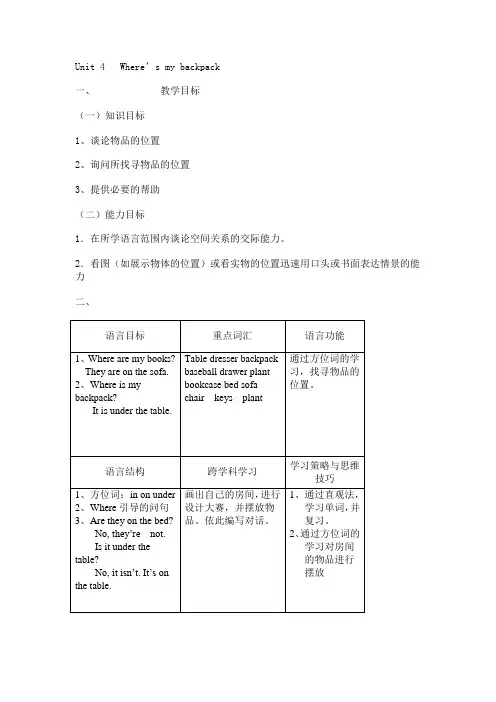
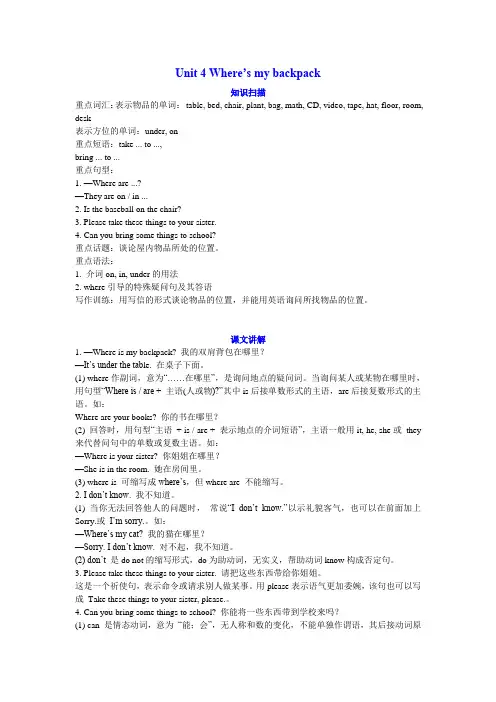
Unit 4 Where’s my backpack知识扫描重点词汇:表示物品的单词:table, bed, chair, plant, bag, math, CD, video, tape, hat, floor, room, desk表示方位的单词:under, on重点短语:take ... to ...,bring ... to ...重点句型:1. —Where are ...?—They are on / in ...2. Is the baseball on the chair?3. Please take these things to your sister.4. Can you bring some things to school?重点话题:谈论屋内物品所处的位置。
重点语法:1. 介词on, in, under的用法2. where引导的特殊疑问句及其答语写作训练:用写信的形式谈论物品的位置,并能用英语询问所找物品的位置。
课文讲解1. —Where is my backpack? 我的双肩背包在哪里?—It’s under the tab le. 在桌子下面。
(1) where作副词,意为“……在哪里”,是询问地点的疑问词。
当询问某人或某物在哪里时,用句型“Where is / are + 主语(人或物)?”其中is后接单数形式的主语,are后接复数形式的主语。
如:Where are your books? 你的书在哪里?(2) 回答时,用句型“主语+ is / are + 表示地点的介词短语”,主语一般用it, he, she或they 来代替问句中的单数或复数主语。
如:—Where is your sister? 你姐姐在哪里?—She is in the room. 她在房间里。
(3) where is 可缩写成where’s,但where are 不能缩写。
2. I don’t know. 我不知道。
Unit 4 Where’s my backpack?单元知识讲解Key words(重点词汇)table bed dresser bookcasesofa chair drawer deskplant bag math math-bookalarm alarm-clock video cassette video-cassettehat thing soccer ballfloor picture wall idealunder on behind between inknow take bring need cannext where tooLanguage points知识要点:1、介词从这里开始,我们就要接触事物和它们所处的空间的关系了。
我们用介词来体现这种关系。
介词后面可以接名词或代词,作为介词的宾语。
如果后面是人称代词的话,要用它的宾格形式,即:him, them, her,us, it, me, you等等。
1). in表示“在……中”,“在……内”。
例如:in our class 在我们班上in my bag 在我的书包里in the desk 在桌子里in the classroom 在教室里2). on 表示“在……上”。
例如:on the wall 在墙上on the desk 在桌子上on the blackboard 在黑板上3). under表示“在……下”。
例如:under the tree 在树下under the chair 在椅子下under the bed 在床下4). behind表示“在……后面”。
例如:behind the door 在门后behind the tree 在树后2、bring和take的区别bring 意思是带来,拿来,取来,指从别处把某人或某物带到或拿到说话者所在的地点来。
例如:Why don't you bring him along? 你为什么不带他一块儿来呢?My books are upstairs; will you bring them down? 我的书在楼上,您可以把它们拿下来吗?Socialism brings us freedom and happiness.社会主义给我们带来了自由和幸福.Take 意思是带去,拿走,和bring相反,指从说话者所在地把某人或某物带去或拿走。